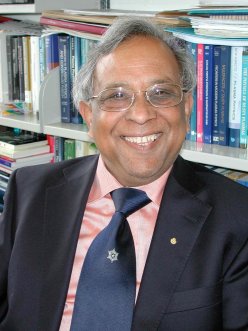The following outline is provided as an overview of and topical guide to physics:
Chalcogenide glass is a glass containing one or more chalcogens. Such glasses are covalently bonded materials and may be classified as covalent network solids. Polonium is also a chalcogen but is not used because of its strong radioactivity. Chalcogenide materials behave rather differently from oxides, in particular their lower band gaps contribute to very dissimilar optical and electrical properties.

The European Physical Journal is a joint publication of EDP Sciences, Springer Science+Business Media, and the Società Italiana di Fisica. It arose in 1998 as a merger and continuation of Acta Physica Hungarica, Anales de Física, Czechoslovak Journal of Physics, Il Nuovo Cimento, Journal de Physique, Portugaliae Physica and Zeitschrift für Physik. The journal is published in various sections, covering all areas of physics.
Dissipative solitons (DSs) are stable solitary localized structures that arise in nonlinear spatially extended dissipative systems due to mechanisms of self-organization. They can be considered as an extension of the classical soliton concept in conservative systems. An alternative terminology includes autosolitons, spots and pulses.
Physica Status Solidi, often stylized physica status solidi or pss, is a family of international peer-reviewed, scientific journals, publishing research on all aspects of solid state physics, and materials science. It is owned and published by Wiley–VCH. These journals publish over 2000 articles per year, making it one of the largest international publications in condensed matter physics. The current editor in chief is Stefan Hildebrandt at the Editorial Office based in Berlin. This office also manages the peer-review process.
Acta Physica Polonica is an open access peer-reviewed scientific journal covering research in physics. It was established by the Polish Physical Society in 1920 as Comptes Rendus des Séances de la Société Polonaise de Physique. In 1970 is split into two journals Acta Physica Polonica A and Acta Physica Polonica B. The two journals became independent in 1995, with series A published by the Institute of Physics of the Polish Academy of Sciences and series B published by the Jagiellonian University in cooperation with the Polish Academy of Arts and Sciences.
IOP Publishing is the publishing company of the Institute of Physics. It provides publications through which scientific research is distributed worldwide, including journals, community websites, magazines, conference proceedings and books. The Institute of Physics is a scientific charity devoted to increasing the practice, understanding and application of physics. Any financial surplus earned by IOP Publishing goes to support physics through the activities of the Institute.
Cybernetical physics is a scientific area on the border of cybernetics and physics which studies physical systems with cybernetical methods. Cybernetical methods are understood as methods developed within control theory, information theory, systems theory and related areas: control design, estimation, identification, optimization, pattern recognition, signal processing, image processing, etc. Physical systems are also understood in a broad sense; they may be either lifeless, living nature or of artificial (engineering) origin, and must have reasonably understood dynamics and models suitable for posing cybernetical problems. Research objectives in cybernetical physics are frequently formulated as analyses of a class of possible system state changes under external (controlling) actions of a certain class. An auxiliary goal is designing the controlling actions required to achieve a prespecified property change. Among typical control action classes are functions which are constant in time, functions which depend only on time, and functions whose value depends on measurement made at the same time or on previous instances. The last class is of special interest since these functions correspond to system analysis by means of external feedback.

Padma Kant Shukla was a distinguished Professor and first International Chair of the Physics and Astronomy Department of Ruhr-University Bochum in Germany. He was also the director of the International Centre for Advanced Studies in Physical Sciences at Ruhr-University Bochum. He held a PhD in physics from Banaras Hindu University in Varanasi, India and a second doctorate in Theoretical Plasma Physics from Umeå University in Sweden.
Frontiers of Physics is a bimonthly peer-reviewed academic journal established in 2006 and co-published by Higher Education Press (China) and Springer Verlag (Germany). Topics covered include quantum mechanics and quantum information; gravitation, cosmology and astrophysics; elementary particles and fields; nuclear physics; atomic physics, molecular physics, optical physics; statistical physics and nonlinear physics; plasma physics and accelerator physics; condensed matter physics; nanostructures and functional materials; and soft matter, biological physics and interdisciplinary physics.
Quantum finance is an interdisciplinary research field, applying theories and methods developed by quantum physicists and economists in order to solve problems in finance. It is a branch of econophysics.
In theoretical physics, the logarithmic Schrödinger equation is one of the nonlinear modifications of Schrödinger's equation. It is a classical wave equation with applications to extensions of quantum mechanics, quantum optics, nuclear physics, transport and diffusion phenomena, open quantum systems and information theory, effective quantum gravity and physical vacuum models and theory of superfluidity and Bose–Einstein condensation. Its relativistic version was first proposed by Gerald Rosen. It is an example of an integrable model.
Hiroomi Umezawa was a physicist and Distinguished Professor in the Department of Physics at the University of Wisconsin–Milwaukee and later at the University of Alberta. He is known for his fundamental contributions to quantum field theory and for his work on quantum phenomena in relation to the mind.
A domain wall is a term used in physics which can have similar meanings in magnetism, optics, or string theory. These phenomena can all be generically described as topological solitons which occur whenever a discrete symmetry is spontaneously broken.
Emilio Del Giudice was an Italian theoretical physicist who worked in the field of condensed matter. Pioneer of string theory in the early 1970s, later on he became better known for his work with Giuliano Preparata at the Italian Institute for Nuclear Physics (INFN);

Edward Ott is an American physicist most noted for his contributions to the development of chaos theory.

The Chinese Physical Society (CPS) a professional society of physicists established in 1932. It is part of the China Association for Science and Technology. Current membership is at around 40,000. CPS has been a member of the International Union of Pure and Applied Physics (IUPAP) since 1984 and of the Association of Asia Pacific Physical Societies (AAPPS) since 1990.
Peter Rudolf Wyder was a Swiss physicist and a professor of experimental solid-state physics at the Radboud University Nijmegen in the Netherlands from 1967 until 1988 and in 1990. Wyder later served as director of the High Field Magnet Laboratory in Grenoble, France.

Wim van Saarloos is a Dutch physicist, academic and researcher. He is a Professor of Theoretical Physics at Leiden University




